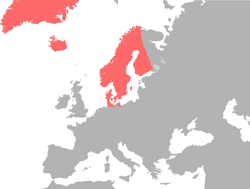| United Kingdom of Denmark, Sweden and Norway Förenade konungariket Danmark, Sverige och Norge (Swedish) Timeline: Cromwell the Great
De Forenede Kongerige Danmark, Sverige og Norge (Dano-Norwegian) Vereinigtes Königreich von Dänemark, Schweden und Norwegen (German) OTL equivalent: Denmark, Norway, Sweden, Finland Iceland, Faroe Islands and Greenland | ||||||
|---|---|---|---|---|---|---|
|
||||||
| Motto: Columna regni sapienta (Latin: Wisdom is the support of the realm) |
||||||
| Royal anthem: Kungssången |
||||||
| Capital (and largest city) | Copenhagen | |||||
| Other cities | Stockholm, Gothenburg, Oslo and Malmö | |||||
| Official languages | Swedish, Danish, Dano-Norwegian and Norwegian | |||||
| Regional languages | Icelandic, Faroe, Finnish, Estonian, Sami and Inuit languages, German, Latin, Livonian, Latvian and Russian | |||||
| Religion | Protestant (National churches of Sweden, Denmark-Norway and Iceland)
Legally recognized (Catholicism and Judaism) |
|||||
| Demonym | Danish or Dane, Swedish or Swede, Norwegian, Finnish or Finn, Icelandic, Faroe Islanders, Greenlander and Scandinavian | |||||
| Government | Absolute monarchy (1764-1812), semi constitutional monarchy (1812-1834) and constitutional monarchy (1834 to date) | |||||
| - | King | Oscar I (House of Oldenburg) | ||||
| - | Statsminister | Gustav Nyberg | ||||
| Legislature | Riksdag of the Estates | |||||
| - | Upper house | Landstinget | ||||
| - | Lower house | Folketing | ||||
| Establishment | ||||||
| - | Joint Crowns of Denmark-Norway and Sweden | 1746-1764 | ||||
| - | United Kingdom of Denmark-Norway and Sweden | 1764-1804 | ||||
| - | Scandinavian Republic | 1804-1808 | ||||
| - | United Kingdom reestablished | 1808 to date | ||||
| Currency | Dano-Norwegian rigsdaler, Danish krone and Swedish riksdaler --> krone/krona (kr.) | |||||
| Time zone | GMT+1 (Scandinavian Time), GMT+2 (Finnish Time), GMT-1 (Icelandic Time) and GMT-3 (Greenlandic Time) | |||||
| Date formats | dd/mm/yyyy (AD) | |||||
| Drives on the | right | |||||
| Membership international or regional organizations | Congress System (member) | |||||
Låt, Svea, dina berg fördubblad ge sin skatt!
Låt skörden blomstra upp i dina skogars natt!
Led flodens böljor kring som tamda undersåter,
och inom Sveriges gräns erövra Finland åter! [1]
(Ur "Svea", Esaias Tegnér 1811).
The United Kingdom of Denmark, Sweden and Norway is a tri-national monarchy of the Scandinavian Peninsula. Also called the United Kingdom of Scandinavia since the 19th century.
History[]
Before the Joint Crowns (pre 1746)[]
The Great Northern War (1700–11) ended with the death of Christian XII in the battle of Poltava. With the victory of the Coalition (Tsardom of Russia and the Kingdom of Denmark-Norway) and the defeat of Sweden prompted a change in the politics and territories of the Scandinavian countries. Besides Sweden being bankrupt and thrown into political chaos, Denmark-Norway was exhausted after the war and worried at the threat of Prussian and its ambitions to control the Baltic Sea and the duchies of Schleswig and Holstein. Queen Ulrika Eleonora of Sweden claims to have a better claim by primogeniture and was recognized as successor of Charles XII by the Riksdag.
As part of the Treaty Ulrika Eleonora married Prince Charles of Denmark (1680-1729) , brother of Frederick IV of Denmark in 1712. Her only child Charles XIII ascended to the throne in 1697 on the abdication of his mother. The new King, influenced by the anti-Russian Hat party, prepared a military campaign to recover the lands lost in the Northern War. Also French diplomacy, which sought to divert Russia's attention from supporting its long-standing ally, the Habsburg monarchy, in the War of the Austrian Succession (1740–48).
The Russo-Swedish Baltic War (1741–43) marked a major defeat of Sweden and the death of Charles XIII in the siege of Riga. Russia pushed harshly in the Treaty of Åbo. The existing Swedish parliament was disbanded after the disaster of war. With no direct heir of Charles XIII and the option of the line of Charles Frederick, Duke of Holstein-Gottorp discarded due to its closeness to Russian, the Riksdag decided to elect Frederick Christian I, brother of Frederick V of Denmark, King of Sweden.
From the Joint Crowns to the Union of the Crowns (1746-1764)[]
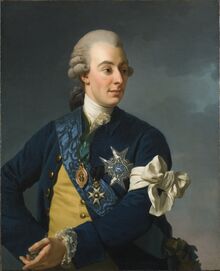
Frederick Christian I (1725-1779) King of Sweden (1743-1764), Denmark (1746-1764) and the United Kingdom of Denmark, Sweden and Norway (1764-1779).
Seldom untimely deaths such as the one of Frederick V of Denmark in 1746 would form a new kingdom. Such was the case this time when on his death and with no child his brother Frederick Christian I of Sweden ascended to the throne of Denmark[2] upon acknowledgement of a joint meeting of the legislatures of Denmark-Norway and Sweden, establishing an informal union of the crowns of Scandinavia.
The United Kingdom was initially established as the personal union of Denmark-Norway and Sweden. An absolute monarchy was already established by the time of the union in Denmark-Norway (Kongeloven of 1665) and Sweden (since 1660). Power was wielded by the king and his ministers and advisors. An important innovation was the creation of joint central counselors, later ministers, for the internal administration, foreign affairs, judiciary, finances, trade customs and the army and the navy.
However, local aristocracy and elites fought over the attempts to centralize the administration and by means of their legislatures of the realm in keeping their privileges and autonomy. To counter this opposition, Frederick Christian I proceeded with the centralization naming loyal high officials and councilors in each realm, rarely calling the legislatures of each realm and major improvements of tax collecting.
King Frederick Christian I proceeded with the reforms in trade and commerce in tune with the ideas of the Enlightened despotism. One major reform was the territorial administration with the creation of the counties in each of the provinces as the main administrative unit under a governor named by the king. The enlargement of the Kommercekollegiet (Board of Trade or The Trade Authority) and extension of its authority to the whole of the United Kingdom to oversee commercial interests of the realm. Thanks to the income from the Sound Dues (or Sound Toll; Danish: Øresundstolden), that provided two thirds of the incomes of the royal treasury, the King was relatively independent of the privy council, aristocracy and legislatures of the realm. This did not stop from building the Eider Canal, once the vassalage of the duchies of Schleswig and Holstein was definitely settled in favour of the Danish Crown and territoriality consolidated the duchies.
[]
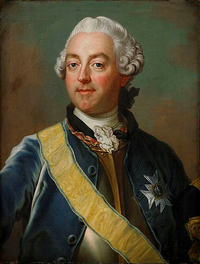
Adolf Frederick (1751-1804) King of the United Kingdom of Denmark, Sweden and Norway (1779-1804).
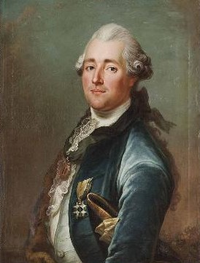
Christian Gustav I (1774-1826) King of the United Kingdom of Denmark, Sweden and Norway (1804-1826).
Adolf Frederick, following the steps of his father, moved to further the centralization, calling a meeting of the delegates of the realm to meet in Copenhagen as the Riksdag of the Estates. In its first assembly (1764) the deputies approved and voted for new taxes, established the norms of the dynastic succession as a Union of the Crowns and approved the Regeringsform of 1764.
The United Kingdom (UK) officially came to being with the Union of the Crowns of 1764 and as specified in the Instrument of Government (Regeringsform 1764) that copied the Danish Kongeloven, it also borrowed and incorporated the high offices and bureaucracy from Sweden, reaffirmed the absolute government, hereditary monarchy with male primogeniture succession, the national religion and its churches, the joint central ministries, the royal courts of justice and the Riksdag of the Estates of the three kingdoms. The legislatures of the realms saw their influence diminished and only served to elect the deputies to the Riksdag of the Estates and judges.
In later years of Frederick Christian I and during Adolf Frederick's reign the joint councilors and high officers of the Kingdom started to regularly meet with the King in the Council of the Realm[3]. The Council meeting under the authority of the King dealt with all administrative, judicial and legislative affairs of the United Kingdom. Also major questions of diplomacy, warfare and internal affairs were discussed, with the King having the final say.
Under Adolf Frederick and Christian Gustav I major reforms that centralized the United Kingdom were decreed, for example the unified tax and treasury of the UK were established, the unified county administration that abolished provincial assemblies and curtailed local administration, the common courts of justice, etc.
On the abolition of the Holy Roman Empire, Holstein was practically, though not formally, incorporated in Denmark. It was only after the European Revolutionary Wars that the duchies of Schleswig and Holstein were united in a Grand Duchy.
However, the revolutionary wars also came to the United Kingdom when French and German republican armies and navies occupied Copenhagen (Battles of Holstein and Jutland) , obligating the King and his court to flee towards Oslo and ship to Britain. Meanwhile, the revolutionaries proclaimed a short-lived Scandinavia Republic (1804-1808).
The short but violent Franco-Rhenanian-Westphalian occupation and establishment of the Scandinavia Republic broke open several contained forces that were held in check or unrepresented during the Age of Absolutism. Resistance organized by Patriots in the form of boycotts, obstruction, propaganda, sabotage and espionage was countered by strict actions from the Republicans. Only in major cities was control assured by Republicans. The countryside was an object of doubtful and circumstantial loyalties in the eyes of the French occupiers and Republican administration.
The expulsion of foreign troops and die-hard Scandinavian republicans marked the return of royalist and patriots under Christian Gustav I. Under pressure, Christian Gustav I enacted the basic freedoms of speech, press, assembly and petition. The reformed Instrument of Government of 1812 (Regeringsform 1812) gave expression to these reforms. Though not a fully liberal and nor a complete constitutional monarchy, the Crown's political agenda became influenced by the interests of bourgeois and incipient capitalists. Political development flourishes, with the exception of republicanism that was outlawed. From the clique gathered around the crown would the liberal and conservative parties form. The Riksdag of the Estate became a bicameral body — Folketing (fully elected) and Landstinget (partially named and with an electoral body different from the Folketing).
The terms of the Peace of Vienna of 1810 were not generous for the ambitions of the United Kingdom in controlling the Baltic Sea. First it lost Swedish Pomerania, acknowledged the creation of the neutral Republic of Pomerania under the terms of the Agreement of Stockholm. However, the United Kingdom regained Finland over the protests of Russia.
[]
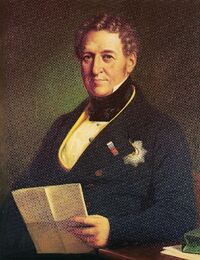
Adolf Frederick II (1797-1860) King of the United Kingdom of Denmark, Sweden and Norway (1826-1860).
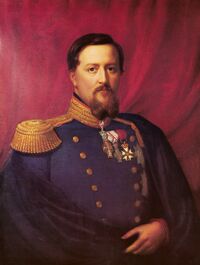
Oscar I (1826-...) King of the United Kingdom of Denmark, Sweden and Norway (1860 to date).
The crowning of Adolf Frederick II marked the start of Reformism in the United Kingdom. As a young prince in exile in the Commonwealth and later a student in Oxford, he was influenced by Liberalism in both Scandinavia and the Commonwealth. On ascending the throne, he embarked on a series of political and economic reforms. Having an avid interest in science he inaugurated numerous academic endeavors and was patron of scientific expeditions notably the Arctic Expeditions of 1828 and 1831. He was the first monarch to open sessions of the Icelandic Althing in person.
The Scandinavian Golden Age, catalyzed by Germanic romanticism, started an exceptional creative production in arts and literature and also scientific and philosophical research. A revival of folkism, enabled the start of modern literature and linguistic revival of Norwegian, Icelandic, Faroe and Finnish. It also marked the start of modern anthropological and folk research of the Sami and Inuit people. The universities of Uppsala, Lund, Oslo, Copenhagen, and the Royal Academy of Åbo became important centers of learning and scientific research. The Golden Age also marked the start of the modern literature movements across Scandinavia in Swedish, Danish, Norwegian and Icelandic.
The Instrument of Government of 1834 (Regeringsform 1834) established full ministerial responsibility to the Riksdag of the Estate and created the offices of the Minister of State (Statsminister) and the Government Council as the ministerial cabinet.
Kings of Denmark, Sweden and Norway[]
- Kings of Denmark-Norway
- Christian V (1646-1699) 1670-1699
- Frederick IV (1671-1730) 1699-1730
- Christian VI (1699-1746) 1730-1742
- Frederick V (1723-1746) 1742-1746
- Frederick Christian I of Sweden (1725-1779) 1746-1764
- Kings of Sweden
- Charles XII (1682-1709) 1697-1709
- Ulrika Eleanor (1688-1741) 1709-1738
- Charles XIII (1713-1743) 1738-1743
- Frederick Christian I (1725-1779) 1743-1764
- Kings of Denmark, Sweden and Norway
- Frederick Christian I (1725-1779) 1764-1779
- Adolf Frederick I (1751-1804) 1779-1804
- Christian Gustav I (1774-1826) 1804-1826
- Adolf Frederick II (1797-1860) 1826-1860
- Oscar I (1826-...) 1860 to date
Political Institutions of the United Kingdom[]
Originally Denmark-Norway and Sweden had separate legal codes and currencies. Each one was administered by a governor-general (statholders in Schleswig and Holstein) named by the King. Following the introduction of absolutism, it followed the centralisation and concentration of state institutions in Copenhagen and the abolition of any collegiate institution outside the rule of the king. All high offices came to be named and responsible to the King. The Lord High Chancellor of the Union became the main counselor and minister of the King.
Dynastic succession and internal revolts of the nobles in the three counties would force, against the wishes of King to re summoned and grant more power to the Estates of the three kingdoms in exchange of hereditary crown, rescinding the established custom of an elective monarchy and remove the rights the Estates and councils of the realm of each kingdom.
The progress towards a unitary state would come possible on a later date. The Instrument of Government (Regeringsform 1764) that copied the Danish Kongeloven and reaffirmed the absolute government, hereditary monarchy with male primogeniture succession, the joint central ministries, the royal courts of justice and the Riksdag of the Estates. The King, assisted by his privy council (the Council of the Realm) , has all executive and legislative authority in the United Kingdom. The Lord High Chancellor in time came to be the chief minister and chair the Council in absence of the King. Also all decrees, proclamations and announcements were co-signed by the Lord High Chancellor under the King's signature or seal.
The European Revolutionary Wars pushed for greater centralization and the final dissolution of the moribund governing councils and states of each of the constituent kingdoms toward a more centralized organization: King, Council of the Ream, the central ministries and the Estates of the Three Kingdoms.
The brief Scandinavia Republic (1804-1808) centralized even more the central government. Though a proposed Scandinavian Union would establish a loose federation its only purpose was to split Scandinavian in several small units under French supervision.
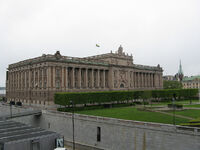
The Riksdag of the Estates.
The reformed Instrument of Government of 1812 (Regeringsform 1812) influenced by the Commonwealth constitutional practices and liberties, exhaustively observed and acclaimed by exiled patriots in Britannia, was promulgated. The King embodies the executive power that is exercised through his appointed ministers. The King names and removes the ministers, but these are responsible to the Riksdag of the Estates for their actions. The king commands the Army and Navy, but war declarations are to be approved by the Riksdag of the Estates. All laws, revenues and budget are to be voted and approved by Riksdag of the Estates. The king has the power of absolute and partial veto on all legislation. The deputies of the Riksdag of the Estates would be directly elected. The right of suffrage was given to all men that qualified according to property and income requirements in the electoral census. A form of censitary suffrage, votes cast weighed according to the person's rank in the electoral census.
Reforms made by the Instrument of Government of 1834 (Regeringsform 1834) established full ministerial responsibility to the Riksdag of the Estate creating the offices of the Minister of State (Statsminister) and the Government Council as the ministerial cabinet. The Minister of State and minister besides being named by the king had also to command a majority or voting confidence of the Riksdag. The office of Lord High Chancellor was limited to its judicial role. The Council of the Realm was abolished as most of its functions were transferred to the Government Council.
Political Parties[]
Until 1788 there were no political parties, only factions or cliques in the royal court, administration and main towns. Public opinion and press were censured. The Regeringsform 1764 had opened the discussion of absolutism or constitutionalism but only among the couriers and crown functionaries and literary salons, without a public appeal. The French Revolution and the European The Revolutionary Wars (1790-1810) saw the emergence of mass politics. The first ones to be established were the Gentry Party in favour of a constitutional monarchy and economic liberalism and the Rights Party advocated strengthening the powers of the Crown and the promotion of rural interests of the landlords.
The French invasion put in power the most radical republicans that persecuted not only the conservative monarchist but also the constitutionalists. The republics, with the support of the occupying commanders and copying the republican reforms, abolished serfdom and all medieval rights and duties. However, the radical republicans were limited in their reforms by the demands of the military campaigns and the authority of the French military governors and their delegates. The royal court exiled in the Commonwealth hinted at the need for reforms.
The end of the occupation and the banishment of the hardest republicans marked a new era as constitutionalism was the political consensus. The right and supporters of the Crown became the National Interest Coalition, the center liberals became the Reform Party and the moderate radicals the Left party. The Regeringsform 1812 partially established a semi-parliamentary monarchy with the support of the NIC and Reform Party, however the Left disagreed in not going far enough in enacting full parliamentary accountability of the government and being shy in giving more liberal rights and universal suffrage.
Trade and Economy[]
In its inception the United Kingdom had an abundance of land and natural resources in Norway and Sweden but with sparse population and mostly concentrated in the Jutland peninsula, Scania, southern and central Sweden, and Oslofjord. Denmark and the duchies at this time were the most developed regions of the kingdoms. However, the economy was largely agricultural and dependent on trade in the Baltic and with Germany and Russia. Most of the commerce was carried out by sea shipping. Mercantilism was the official economic policy until the 1790s when in order to promote commerce and industry most of the restrictive clauses and monopolies were terminated under the economic reforms of Adolf Frederick that created modern banks and corporations. The abolition of guild monopolies on craftsmen made possible the creation of new crafts and adoption of new technologies.
The reforms of Frederick Christian I started a trend in the agricultural economy that shifted gradually from communal villages to a more efficient private farm-based agriculture, especially in Denmark and Sweden. Also the abolition of serfdom freed captive land labourers that state to emigrate to the cities.
These reforms started an agricultural revolution with larger agricultural estates (land reclamation and enclosures), the crown transferring areas to private farmers, new crops and farming tools and a commercialization of farming, and a proto industrialisation, with small industries being established in the countryside and with workers switching between agricultural work in the summer season and industrial production in the winter season.
Following the French Revolutionary Wars, Scandinavia shifted from mercantilism to a more liberal economy. It Has one of the oldest central banks, the Riksbank, with a monopoly on currency issues. The krone/krona (kr.) replaced the already existing Dano-Norwegian rigsdaler, Danish krone and Swedish riksdaler.
Although introduction of steam power and machinery was late in the United Kingdom in relation to the British, Dutch and Flemish it became concentrated in shipbuilding, cargo transport and ore extraction in the interior lands of Scandinavia. (see Industrial Revolution)
As in most European nations the chartered companies — the Danish East India Company and the Swedish East India Company— had the monopoly of commerce with the East Indies. In order to maximize profits and minimize cost, and as a response to the restrictions and perils of the Carnatic Wars, both companies were merged in the Asiatic Trade Company.
The Kingdoms and Realms[]
- Former territories
Overseas territories[]
Colonies of the United Kingdom of Scandinavia.
| Name
Notes |
Area (km²) |
Population | Capital | Legislature | Languages |
|---|---|---|---|---|---|
| Scandinavian Gold Coast (1766 to date)
Colony of the Realm of the United Kingdom. Merger and consolidation of former Swedish Gold Coast and Danish Gold Coast |
Osu (Christiansborg) | No | Ga, Dangme, Ewe, Akan, Swedish and Danish | ||
| Tranquebar (or Trankebar) 1620 to date.
Trading outpost |
No | Tamil, Swedish and Danish | |||
| Frederiksnagore (or Serampore) 1755 to date.
Trading outpost |
No | Bengal, Swedish and Danish |
| |||||||||||||||||||||||
- ↑ Let Svea, your mountains double, give their treasure! Let the harvest flourish in the night of your forests! Lead the river's waves around as tamed subjects, and within Sweden's border conquer Finland again!
- ↑ According to Danish Kongeloven succession rights were acquired through the male line. Had the deceased king no sons, the throne went over to his younger brothers and then to the sons of his father's brother, etc. When the male line was exhausted, the throne should go to the daughter of the last king and on to her son.
- ↑ Riksrådet (in Norwegian and Swedish), Rigsrådet (in Danish)



